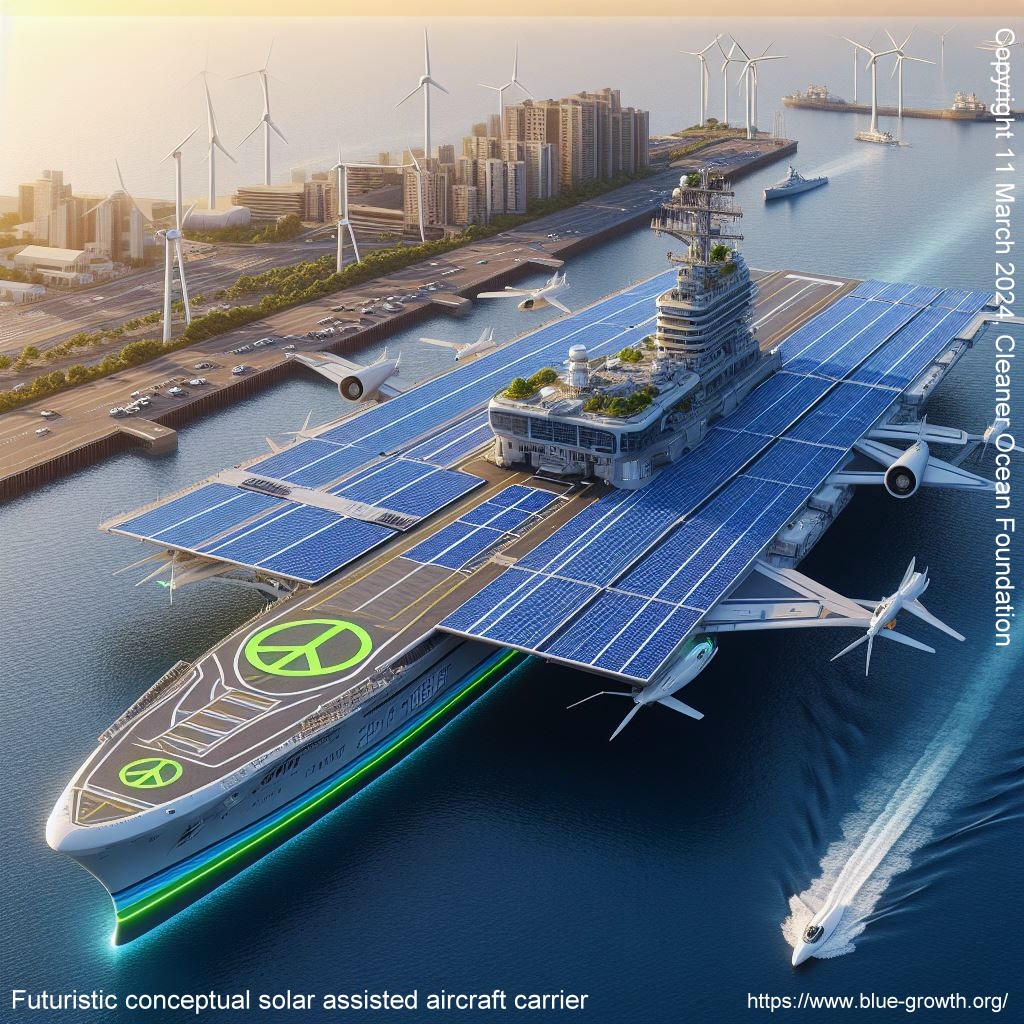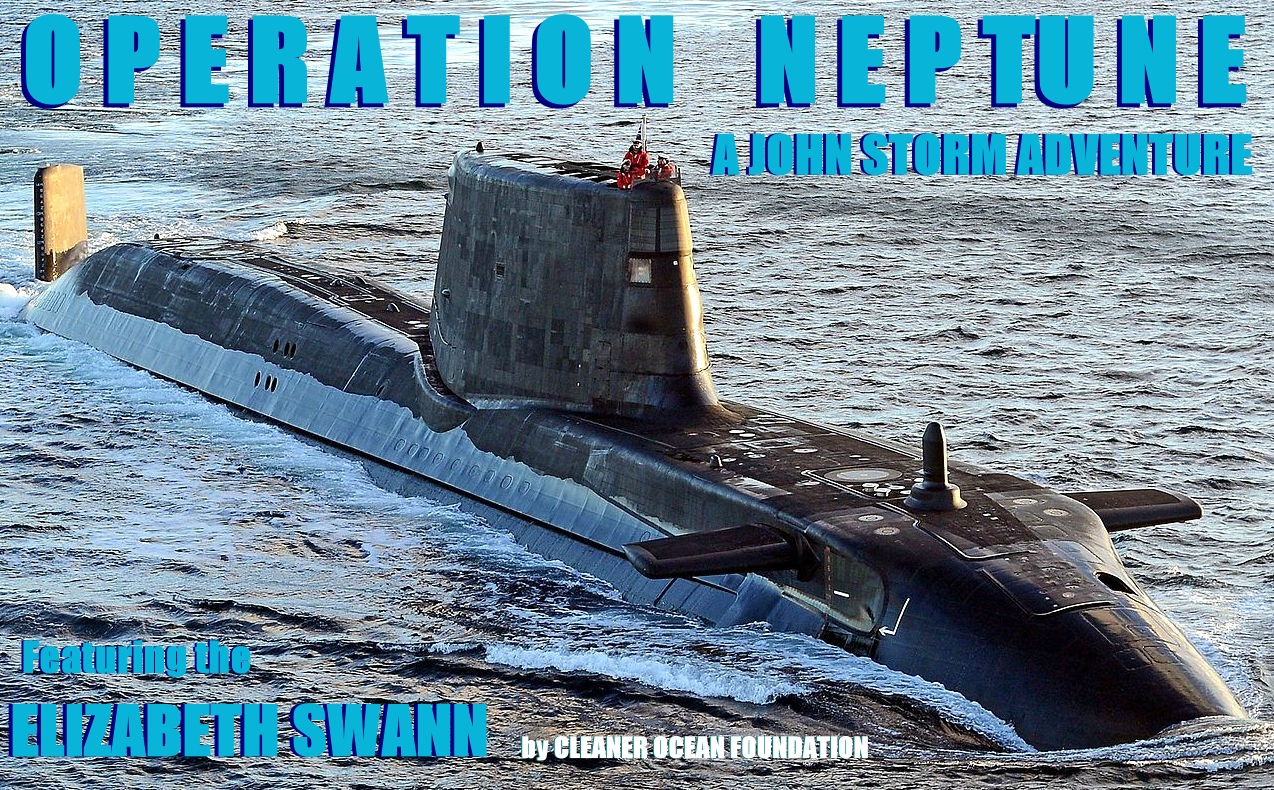Blue Growth
is the long term strategy to support sustainable growth in the marine
and maritime sectors as a whole. Seas and oceans are drivers for the
International community and European economy, and have great potential for innovation and growth. It
is the maritime contribution to achieving the goals of the Europe 2020
strategy for smart, sustainable and inclusive
growth, now moving towards 2030 and beyond.
MILITARY
Blue growth may also carry a
military
interpretation, overlaid, or as underlying policies. Such as food security being essential, to support efforts to secure peace, where some nations are pursuing varying degrees of
aggressive economic expansion, illegally, our waters have to be policed.
EUROPEAN UNION
In the EU, blue growth is important because marine and maritime
activities provide employment for approximately 5.4 million people in
the EU and contribute to a gross value added (GVA) of nearly EUR 500
billion per year. The strategy recognizes that tailored approaches are
necessary for Europe’s seven sea basins: Adriatic and Ionian Seas,
Arctic Ocean, Atlantic Ocean, Baltic Sea, Black Sea, Mediterranean Sea,
and North Sea.
The concept is not limited to Europe, rather, the principles are
applied internationally in varying degrees, for example, in terms of
fishing and fish catches. BLUE GROWTH ROOTS
The roots of the blue growth concept can be traced back to the
conceptualization of sustainable development (SD). Sustainable
development - or the challenge of a sustainable use of natural
resources, while at the same time securing economic and social
objectives - has been a focus of the international community since the
1960s.
Three large international conferences mark the main milestones in
the development of the SD concept: the environmental/resource dimension
was defined in Stockholm in 1972 at the first United Nations (UN)
conference on SD; the economic dimension, in Rio 1992 at the second UN
conference on SD; and the social dimension in Johannesburg 2002 at the
third UN conference on SD. Leading up to the fourth conference on SD,
Rio + 20 held in Rio in 2012, a new concept took center stage at the
backdrop of the international financial crisis. The concept was “green
growth”. According to the Organization for Economic Cooperation and
Development (OECD) “green growth means fostering economic
growth and development while ensuring that natural assets continue to
provide the resources and environmental services on which our well-being
relies.”
Realizing the traction of this new concept, and the close
association of it to growth derived from terrestrial ecosystems, a group
of small island nation states (SIDS) emphasized the importance of the
blue economy - that is the multi-faceted economic and social importance
of the ocean and inland waters - and the importance of “blue growth”. [4]
At the Rio + 20 conference, the
Food and Agricultural Organization
(FAO) supported these views and sent a very strong message to the
international community that a healthy ocean ecosystem ensured by
sustainable farming and fishing operations was a prerequisite for a blue
growth.
Since the Rio + 20 conference, the blue growth concept has been
widely used and has become important in aquatic development in many
nation states, regionally as well as internationally. The FAO, for
example, launched its Blue Growth initiative, the aim of which is to
“secure or restore the potential of the oceans, lagoons and inland
waters by introducing responsible and sustainable approaches to
reconcile economic growth and
food security
with the conservation of aquatic resources”, and the EU´s blue-growth
strategy emphasizes the importance of marine areas for innovation and
growth in five sectors in addition to increased emphasis on marine
spatial planning and coastal protection.
OBSTACLES
One of the most obvious obstacles to attaining the 'blue-growth'
ideal is the lack of a common and agreed-upon set of goals. For some,
blue growth revolves around maximizing economic growth derived from
marine and aquatic resources, but for others it means maximizing
inclusive economic growth derived from marine and aquatic resources and
at the same time preventing degradation of blue natural capital.
These interpretations apply more to peace loving nations. The lack
of common objectives, or understanding, could explain the many and
varied interpretations and
approaches, in not quite speaking the same language across sectors.
According to Socialist nations hold very different views on
'blue-growth' to democracies, under the head of 'maritime
sustainability.'
EUROPA
Marine and maritime activities provide work for 5.4 million people
in the EU and account for a gross value added (GVA) of just under EUR
500 billion per year. In 2012, the EU presented a long-term strategy to
harness the potential of its
rivers,
oceans and
seas.
The European Commission launched the European Union (EU) strategy
for the maritime sector. The strategy - known as Blue Growth — is the
maritime sector’s contribution to achieving the goals of the Europe 2020
strategy for smart, sustainable and inclusive growth. It builds upon
the Commission's Integrated Maritime Policy launched in 2007.
KEY POINTS - EU OUTLOOK
The Blue Growth strategy focuses on the potential of marine and
maritime sectors (the blue economy) to contribute to sustainable
economic recovery in the EU, and in particular to create new jobs and
promote innovation and sustainable growth.
Maritime regions and their coasts, because of their unique
geographical situation (i.e. looking outwards) have traditionally been
centres for new ideas and innovation. However, there are 3 new factors
which are likely to further reinforce their potential in this regard:
— In the past decade, there has been rapid technological progress (particularly in
robotics, video-surveillance and
submersible technology) in working offshore in ever-deeper waters.
— With population
growth, there is ever-increasing pressure on land-based
resources to provide food and energy. We need to look at the 71 % of the
earth's surface that is ocean to find more sustainable ways of meeting
human needs.
— Our seas have an important part to play in helping to reduce greenhouse gas emissions, by means of
offshore renewable energy installations, and in saving energy thanks to transport by sea which is less polluting than land transport.
The strategy identifies 5 sectors that have high potential for jobs and growth. These sectors are: 1.
aquaculture
(fish and
shellfish farming), 2.
tourism, 3.
marine
biotechnology, 4.
ocean energy and 5.
seabed mining.
A set of Commission initiatives has been launched to explore and
develop the growth potential in these areas. These include
Communications on:
— coastal and maritime tourism
— ocean energy
STRATEGIC GUIDELINES ON AQUACULTURE
The strategy highlights the importance of:
— increasing marine knowledge (to develop new products and services);
— improving the management of marine activities — this is vital in
order to avoid potential conflict and to create synergies between
different activities;
— security (i.e. integrated maritime surveillance) of the EU’s
waters to allow maritime authorities to share information on risks and
threats.
It also recognises that tailored approaches need to be taken in relation to Europe's 7 sea basins
(Adriatic and
Ionian Seas,
Arctic
Ocean, Atlantic
Ocean, Baltic
Sea, Black
Sea, Mediterranean Sea and
North
Sea). This ensures that each basin's individual needs are met and seeks to encourage the countries involved to work together.
OUTSIDE THE EU
Let’s explore how different countries approach maritime sustainability and their policies related to marine management:
UNITED STATES
United States: The US Marine Corps has been reshaping its strategy to address the
China
threat in the Indo-Pacific region. The plan, known as Force Design
2030, aims to equip the Marines for potential conflict with China by
focusing on dispersed operations across chains of islands. Units will be
smaller, more spread out, and armed with new weapons systems. Notably,
the plan involves
cutting back on foot soldiers and eliminating
tanks.
Additionally, the United States cooperates with China and Russia on issues such as
piracy, smuggling, and
climate change that impact stability at sea. This consensus highlights the need for collaboration to protect global maritime trade.
RUSSIA
Russia: Russia has recently updated its Maritime Doctrine to address
challenges and threats to national security. The comprehensive document
outlines priorities for maritime activities, mobilization training,
readiness, and procedures for using national maritime instruments.
While Russia is part of the RIC (Russia-India-China) grouping, it has also engaged in dialogue with
India and China despite border tensions. The RIC alignment has deepened institutionally, including defense ministers’ dialogues.
INDIA
India: India follows a policy of multi-alignment, cooperating with
various partners to manage its relations with China. Despite improving
ties with the
United
States, India maintains engagement with Russia and China to mitigate risks.
India’s participation in the RIC summits and defense ministers’
dialogues demonstrates its commitment to regional stability and
cooperation. CHINA
China’s approach to sustainable marine management involves balancing
economic growth with environmental conservation. As a major player in
the
Indo-Pacific, China faces challenges related to
over-fishing,
pollution, and territorial
and other disputes, including trade routes into and through the Indian
Ocean.
China has made efforts to promote sustainable fishing practices, marine conservation, and research. However, tensions persist in the
South China Sea due to territorial claims and resource exploitation. In
summary, each country adopts its unique approach to maritime
sustainability, considering geopolitical dynamics, economic interests,
and environmental concerns. Collaboration and dialogue among nations are
crucial for effective marine management and safeguarding our oceans for
future generations.
The not for profit ideals of the Cleaner Ocean
Foundation, though trustees are aware of the militaristic interpretation of
'blue-growth,' only concerns itself with sustainable,
or zero
emission waterborne transportation (ZEWT), ocean pollution,
scientific exploration and conservation issues. UNITED
NATIONS CONVENTION ON THE LAW OF THE SEA The
United Nations
plays a crucial role in advocating for ecological conservation of
marine assets and promoting policies that balance economic development
with environmental sustainability. Let’s delve into
the United Nations Convention on the Law of the Sea: A Cornerstone for World Peace. The
UNCLOS, adopted in 1982, is often referred to as the
“Constitution of the Oceans.” It provides a comprehensive legal
framework governing the use and management of the world’s oceans and
seas.
UNCLOS plays a pivotal role in maintaining peace by providing a
legal framework, resolving disputes, and promoting responsible ocean
management. As we navigate the complexities of our interconnected world,
UNCLOS remains a beacon of cooperation and shared responsibility for
the benefit of all humankind The
vast expanse of the world's oceans has long been a source of wonder,
bounty, and, at times, conflict. The United Nations Convention on the
Law of the Sea (UNCLOS), adopted in 1982, stands as a landmark
achievement in establishing a comprehensive legal framework for the use
of the world's oceans and seas. This essay will explore the key
provisions of UNCLOS and how this convention plays a vital role in
promoting world peace.
Establishing Clear Boundaries and Rights
One of UNCLOS's most significant contributions is the creation of a
clear legal framework defining the rights and responsibilities of
nations concerning the use of the oceans. Prior to UNCLOS, competing
claims to territorial waters and maritime resources often led to
tensions and disputes. The Convention established a system of zones,
including territorial seas, exclusive economic zones (EEZs), and the
international seabed area (the Area). This delineation of maritime zones
provided nations with clear legal boundaries within which they have
exclusive rights to explore and exploit resources.
Promoting Peaceful Dispute Resolution
UNCLOS recognizes that disagreements over maritime claims and
resource utilization are inevitable. However, it provides a robust
framework for peaceful dispute resolution. The Convention outlines a
series of options, including negotiation, conciliation, and arbitration.
The International Tribunal for the Law of the Sea (ITLOS) serves as a
critical mechanism for resolving disputes peacefully and in accordance
with international law. This reduces the risk of escalating tensions
into military confrontation.
Ensuring Responsible Environmental Management
UNCLOS recognizes the delicate balance of the marine environment and
emphasizes the importance of its sustainable use. The Convention
mandates nations to protect and preserve the marine environment from
pollution and degradation caused by activities like dumping and
exploration. It also establishes a framework for cooperation in marine
scientific research and promotes the conservation of marine living
resources. By fostering responsible practices, UNCLOS helps to ensure
the long-term health and sustainability of the oceans, a shared resource
for all nations.
Promoting Free Navigation and Security
UNCLOS guarantees the freedom of navigation for all states on the
high seas. This includes the freedom of navigation, overflight, fishing,
and scientific research. This principle ensures that vital trade routes
remain open and accessible, promoting global economic security and
cooperation. Additionally, UNCLOS encourages cooperation in combating
piracy, terrorism, and other threats at sea, fostering a more secure
maritime environment.
Challenges and the Road Ahead
Despite its successes, UNCLOS faces ongoing challenges. New issues,
such as deep-sea mining and climate
change, necessitate ongoing
discussions and potential revisions to the Convention. Ensuring
compliance with its provisions remains a complex task, and robust
enforcement mechanisms are crucial. The
United Nations Convention on the Law of the Sea is a cornerstone of a
peaceful and prosperous world. By establishing clear legal frameworks,
fostering peaceful dispute resolution, and promoting responsible
environmental management, UNCLOS provides a foundation for the
sustainable use and security of the world's oceans. As we navigate the
complexities of the 21st century, upholding and strengthening UNCLOS
remains critical for ensuring the continued peaceful use of our shared
maritime commons. SUSTAINABLE
NAVAL OPERATIONS FOR PEACEKEEPING Navies
of the world should strive to temper their game plan in compliance with 21st
Century sustainable
naval peacekeeping, as a highly prized pinnacle, against the
background of IMO clean air legislation, and United Nations' targets. Such
attainment being social, moral and spiritual guidance to other nations in
terms of world leadership. In itself a stabilizing attribute to be admired
and emulated.
|


